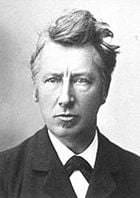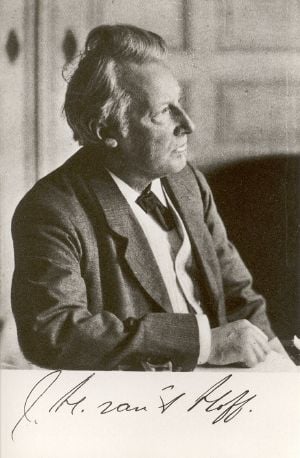Jacobus Henricus van 't Hoff
| Jacobus Henricus van 't Hoff | |
|---|---|
| Dutch chemist | |
| Born | August 30, 1852 Rotterdam, Netherlands |
| Died | March 1, 1911 Steglitz, Berlin, Germany |
Jacobus Henricus van 't Hoff (August 30, 1852 - March 1, 1911) was a Dutch physical and organic chemist and the winner of the inaugural Nobel Prize in chemistry. His research on chemical kinetics, chemical equilibrium, osmotic pressure and crystallography is credited to be his major work. Van 't Hoff helped to found the discipline of physical chemistry as we know it today.
Early days
He was born in Rotterdam, the son of a medical doctor. From a young age he was interested in science and nature; he frequently took part in botanical excursions, and his receptiveness for philosophy and his predilection for poetry were already apparent in his early school years. (Lord Byron was his idol.) Against the wishes of his father, he went to study chemistry, first at the Delft Polytechnic Institute, then at the University of Leiden, then to Bonn, Germany (where he studied with Friedrich Kekulé), then Paris (where he studied with C. A. Wurtz), finally receiving his doctorate at the University of Utrecht in 1874. In 1878 Van 't Hoff married Johanna Francina Mees. They had two daughters, Johanna Francina (b. 1880) and Aleida Jacoba (b. 1882), and two sons, Jacobus Hendricus (b. 1883) and Govert Jacob (b. 1889).
Contributions to chemistry and major works
Before receiving his doctorate, Van 't Hoff had already published the first of his important contributions to organic chemistry. In 1874 he accounted for the phenomenon of optical activity by assuming that the chemical bonds between carbon atoms and their neighbors were directed towards the corners of a regular tetrahedron. This three-dimensional structure perfectly accounted for the isomers found in nature (stereochemistry). He shares credit for this idea with the French chemist Joseph Le Bel, who independently came up with the same idea.
In 1884 Van 't Hoff published his research on chemical kinetics, naming it Études de Dynamique chimique ("Studies in Chemical Dynamics"), in which he described a new method for determining the order of a reaction using graphics, and applied the laws of thermodynamics to chemical equilibriums. He also introduced the modern concept of chemical affinity. In 1886 he showed a similarity between the behaviour of dilute solutions and gases. Until 1895 he worked on Svante Arrhenius's theory of the dissociation of electrolytes. On 1896 he became professor to the Prussian Academy of Science at Berlin. His studies of the salt deposits at Stassfurt contributed to Prussia's chemical industry. In 1887 he and German chemist Wilhelm Ostwald founded an influential scientific magazine named Zeitschrift für physikalische Chemie ("Journal of Physical Chemistry").
Winner of the inaugural Nobel Prize in chemistry
Van 't Hoff became a lecturer in chemistry and physics at the Veterinary College in Utrecht. He then became a professor of chemistry, mineralogy, and geology at the University of Amsterdam for almost 18 years before eventually becoming the chairman of the chemistry department. In 1896 Van 't Hoff moved to Germany where he finished his career at the University of Berlin in 1911. In 1901 he received the first Nobel Prize in chemistry for his work with solutions. This can generally be summarized by stating that very dilute solutions follow mathematical laws that closely resemble the laws describing the behavior of gases.
Final days, awards and legacy
In 1885 he was appointed member of the Royal Netherlands Academy of Sciences. Other distinctions included the honorary doctorates of Harvard and Yale 1901, Victoria University, Manchester 1903, Heidelberg 1908; the Davy Medal of the Royal Society 1893 (along with Le Bel), Helmholtz Medal of the Prussian Academy of Sciences 1911; he was also appointed Chevalier de la Legion d'Honneur 1894, Senator der Kaiser-Wilhelm-Gesellschaft (1911). Van't Hoff was also honorary member of the British Chemical Society in London, the Royal Academy of Sciences, in Göttingen 1892, American Chemical Society 1898, and the Académie des Sciences, in Paris 1905.
He was indeed a prominent scientist of its time. Of his numerous distinctions, he regarded his winning of the first Nobel Prize in Chemistry as the culmination of his career.
Van 't Hoff died at the age of 58, on March 1, 1911, at Steglitz near Berlin.
See also
- Van 't Hoff factor
- Van't Hoff equation
ReferencesISBN links support NWE through referral fees
- H.A.M. Snelders, Hoff, Jacobus Henricus van 't (1852-1911), in Biografisch Woordenboek van Nederland.
- Jacobus Henricus van 't Hoff. Recognition of the extraordinary services he has rendered by the discovery of the laws of chemical dynamics and osmotic pressure in solutions. Retrieved September 18, 2005.
- Museum Boerhaave Negen Nederlandse Nobelprijswinnaars
|
1901: Jacobus Henricus van 't Hoff | 1902: Hermann Emil Fischer | 1903: Svante Arrhenius | 1904: William Ramsay | 1905: Adolf von Baeyer | 1906: Henri Moissan | 1907: Eduard Buchner | 1908: Ernest Rutherford | 1909: Wilhelm Ostwald | 1910: Otto Wallach | 1911: Marie Curie | 1912: Victor Grignard, [Paul Sabatier | 1913: Alfred Werner | 1914: Theodore William Richards | 1915: Richard Willstätter | 1918: Fritz Haber | 1920: Walther Nernst | 1921: Frederick Soddy | 1922: Francis William Aston | 1923: Fritz Pregl | 1925: Richard Adolf Zsigmondy |
bs:Jacobus Henricus van 't Hoff bg:Якоб Вант Хоф ca:Jacobus Henricus van 't Hoff cs:Jacobus Henricus van 't Hoff de:Jacobus Henricus van 't Hoff es:Jacobus Henricus van 't Hoff eo:Jacobus Henricus Van T'Hoff fr:Jacobus Henricus van 't Hoff fy:J.H. van 't Hoff ko:야코뷔스 헨드리퀴스 판트호프 hr:Jacobus Henricus van 't Hoff io:Jacobus Henricus van 't Hoff id:Jacobus Henricus van 't Hoff it:Jacobus van 't Hoff he:יאקובוס ואן 'ט הוף hu:Jacobus Henricus van 't Hoff nl:Jacobus van 't Hoff ja:ヤコブス・ヘンリクス・ファント・ホッフ no:Jacobus Henricus van 't Hoff nov:Jacobus Henricus van 't Hoff oc:Jacobus Henricus van 't Hoff pl:Jacobus Henricus van't Hoff pt:Jacobus Henricus van't Hoff ru:Вант-Гофф, Якоб Хендрик sk:Jacobus Henricus van 't Hoff sl:Jacobus Henricus van 't Hoff fi:Jacobus Henricus van 't Hoff sv:Jacobus Henricus van 't Hoff


